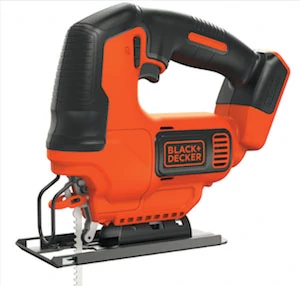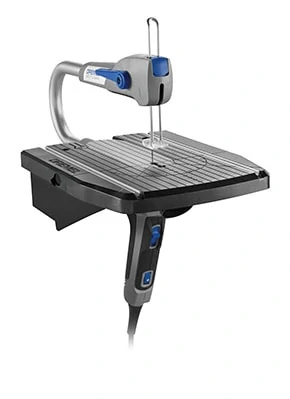By Matt Weber
Jigsaws are lightweight, easy to use and extremely versatile. To some degree, a jigsaw can perform the duties of a band saw, a scroll saw and even a circular saw. Use it to make cut-outs in wallboard, notch flooring around a corner, or rough-cut large pieces of plywood before hauling them to the table saw. Jigsaws are exceptionally good for making tighter, more intricate cuts. The traditional “jigsaw” puzzle, with its tightly curved and complex network of cutout pieces, illustrates the maneuverability of the tool and the detailed cuts that the narrow blade of a jigsaw is capable of achieving. A great saw for both basic home repairs and advanced woodworking, the tool is used to cut curves, holes and scroll work for projects such as cabinets, countertops, furniture, woodcrafts and more.
Saw Selection
When shopping for a new jigsaw, focus on the features that will make everyday use a piece of cake. When holding the saw, is it lightweight and well balanced? Is it easy to see the point where the blade meets the wood? This is a critical area when making cuts, and without a clear view you’ll struggle with accuracy.
Blade alignment is another important feature. Some manufacturers offer disposable plastic guides to hold the blade in alignment with the base. Other manufacturers offer solid metal guides. The metal guides usually offer more reliable blade alignment.

Most traditional jigsaw models feature D-shaped horizontal handles. However, many newer styles feature “barrel grip” handles, which are palm-sized handles positioned directly above the cutting point of the saw and designed for better balance and control. Handle design is really a matter of personal preference. Many people love the barrel-grip design, especially when used for bottom-up vertical cuts, but just as many have grown accustom to the more traditional style.
One welcome feature of many modern jigsaws is an easier blade-change system. Changing blades, which used to be an awkward process requiring special tools, now can be done using only dials or switches to release the blade for easy removal. Bosch offers a “One Touch” blade-change system on some of its models that ejects hot or broken blades with the pull of a lever.
Other handy features include variable speed control. On some saws the blade speed, or the number of blade strokes per minute, can be adjusted with a dial or a variable speed trigger. A light touch on the trigger produces a slow cutting motion; pressing harder increases the blade speed and the aggressiveness of the cut.
In addition to speed control, some jigsaws offer orbital cutting action that controls the horizontal motion in the cutting action of the blade. With the flip of an orbital selection switch, a horizontal motion is introduced into the vertical motion of the blade. This improves the speed of the cutting process.
Making the Cut
The jigsaw is a hand tool that you push over the material, but in some situations the jigsaw be mounted to a stand and fixed upside-down on a bench. This allows the material to be pushed into the jigsaw, as when using a band saw.
The limitations of jigsaws lie in their thickness of cut. They’re designed to cut completely through material—not partially through a workpiece—and stock thicker than about 1-1/2 inches is typically too thick for jigsaw work. They also have trouble cutting a straight line, however the problems of cutting a straight line with a jigsaw can generally be solved by using a saw guide.
To perform a standard cut, make sure the workpiece is secured to a sturdy work surface. Place the saw’s footplate flush against the cutting surface. Make sure the blade is not going to come into contact with the workbench—or the electrical cord — when making the cuts. You may want to drill a pilot hole for the blade for cuts that are not made from the material’s edge. Start the blade then slowly push the saw forward to penetrate the material.

Rule number one for jigsaw use: Let the saw blade do the work. Manual pressure is not going to help the cutting action, and too much forward pressure will reduce the quality of cut and wear out the blade—possibly even break it.
Straight-line Cuts. Use a firmly clamped, straight guide fence to make long, straight regular or bevel cuts. For further accuracy on straight cuts, a wider jigsaw blade is less likely to curve outward than a skinny blade. Also, use a slower blade speed. Slower speeds generally allow more accurate cuts.

Bevel Cuts. To produce angled or beveled cuts, rotate the footplate by loosening the screw or adjustment lever at the bottom of the saw. Many of today’s jigsaws offer an angled cut adjustable to 45 degrees. Adjust the footplate then retighten the screw. Make a test cut to measure the angle’s accuracy before making the actual production cuts.
Turning Corners. Narrow blades are more capable of making tighter turns than wider blades.
A simple solution for tight turns is to drill a pilot hole on the waste side of the workpiece to easily reposition the blade. Or, make sequential cuts that intersect at the corner.
When cutting round corners, use a compass to mark the radius. On intricate curved shapes, trace the layout of the cut, and then determine the direction and sequence of your individual cuts before beginning. Make sure all the marked cutting area extends beyond the edge of the workbench.
Plunge Cuts. Hold the saw with both hands and position the front end of the footplate firmly on the work piece. With the blade positioned nearly 90 degrees to the work surface and set for vertical cutting action (not orbital), start the saw and slowly tilt the blade back to a flat position, penetrating the material. Plunge cuts are fine for rough cuts, but they’re not very accurate, making this method ill-advised for finish work.
Blade Selection
When strolling the aisles of the local hardware store, you’re likely to find an almost overwhelming assortment of jigsaw blades. To select the right blade, you need to know a few basic facts. What type of material do you plan to cut—wood, metal, plastic or other? What type of cuts will you be making—tight cuts, rough cuts, scrolling or a combination?

Easing the selection process, most jigsaw blades from major companies such as DeWalt and Bosch indicate the blades’ recommended material applications right on the package.
One of the most important things to consider is the number of blade teeth per inch. Most woodcutting blades have as many as 12 teeth per inch, while metal-cutting blades may have up to 36. Generally speaking, the fewer the teeth, the faster the blade will cut. However, blades with fewer teeth also mean a rougher cut.

The material’s thickness is another point to consider when choosing blades. As a rule of thumb, at least three blade teeth should be simultaneously cutting the material at all times. This means thinner materials should be cut with a blade with finer teeth.

Most jigsaw blades are made from carbon steel. These are great blades for cutting wood, but bi-metal blades are recommended for cutting metal. Bi-metal blades have extremely hard steel teeth joined to a blade body of softer carbon steel. The high-strength teeth maintain an edge much longer than carbon steel. The carbon steel, however, allows the blade to bend during use without breaking.
Also be sure the style of blade you select is compatible with your jigsaw. Some saws accept T-style blades while others accept “universal” blades. Some saws will accept either type of blade. Keep in mind that there is a lot of overlap among jigsaw blades and it might not be necessary to change blades with every job. Some blades may be specified for a certain application, but in a pinch they may work fine for cutting that 2-by-4 lying across your bench. Specialty blades are also available for jobs such as cutting leather, foam rubber or plastic.

Thanks to today’s innovations, jigsaws are easier to master than ever. With a little shopping, a little practice and the right blade you’ll find uses for a jigsaw around every corner of your home.
Side Note 1
Quick Jigsaw Tips
- Use waste material to your advantage. Waste areas allow room to move the saw and approach a difficult cut from a new angle.
- For a narrow, rectangular cutout, make several straight cuts at gradually widening angles up to the adjacent cross-angle of the rectangle, until you’ve achieved an opening large enough to turn the blade around.
- To minimize splintering, cut along the grain of the wood as much as possible. When cutting laminated materials, mask the cut lines with tape to minimize chipping.
- Prevent cutout sections from splintering at the final intersecting cut by securing a C-clamp over the previously cut areas, holding the cutout piece in place.
Side Note 2
Dremel Moto-Saw
The Dremel Moto-Saw is a portable, precision-sawing tool for making detailed cuts in a variety of materials including wood, plastic, laminates and metal. It’s essentially two tools in one: The Moto-Saw functions as a stationary scroll saw, but it can be removed from its base to be used as a portable motorized coping saw. An auto-tensioning feature keeps the blade tight and ready to cut so you don’t have to make blade adjustments, and its slim, ergonomic handle with comfort grip provides control in any cutting position. It’s easy to store, set-up and operate and features a tool-free mechanism for quick blade changes. Visit www.dremel.com.





